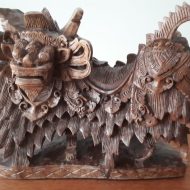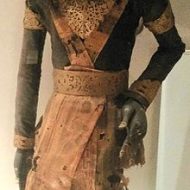Barong : The Protector of Bali
Listen
At a glance
| Description | |
|---|---|
| Origin | Indonesian Mythology |
| Classification | Hybrids |
| Family Members | N/A |
| Region | Bali (Indonesia) |
| Associated With | Protection |
Barong
Introduction
Barong, a masked character, typically represents an enigmatic being known as keket and makes appearances during festive occasions in Bali, Indonesia. In Balinese culture, Barong stands as a symbol of well-being and prosperity, contrasting with the malevolent witch Rangda, also called Calonarang. In a captivating dance-drama, featuring the renowned kris (an ancestral sword) dance, performers enter deep trances and perform acts of self-piercing with the swords, emerging unscathed. In this mesmerizing spectacle, Barong engages in mystical combat with Rangda. The embodiment of Barong is achieved through the collaborative effort of two dancers adorned in an intricately adorned harness. The figure’s mask is complemented by a beard made of human hair, embellished with frangipani flowers, believed to house the magical essence of Barong.
Physical Traits
The Barong, a guardian spirit, is frequently symbolized as a lion and is commonly depicted in the company of two monkeys. This lion-like Barong features a red head, a coat of dense white fur, and is adorned with ornate gilded jewelry adorned with fragments of mirrors. The lion Barong’s form bears a resemblance to that of a Pekingese dog.
Family
The origins of the Barong are far back in time and quite uncertain. Its origins could be from animist worship, before Hinduism appeared, when villagers still believed in the supernatural protective power of animals. Some stories also attribute Banaspati Radja as the Barong’s father and also Baskara and Ratih as siblings.
Other names
The Barong Ket, also known as the Lion Barong, is the most widely recognized form of this mythical creature in Balinese culture. However, it occasionally assumes different incarnations, each with its unique symbolism. One of these variations is the Barong Celeng, embodying the essence of a boar. Another form is the Barong Macan, which represents the majestic tiger. There’s also the Barong Naga, symbolizing the mythical dragon or serpent. Last but not least, the Barong Gajah takes on the form of an elephant, each of these forms carries its own significance and plays a distinctive role in Balinese traditions and rituals.
Powers and Abilities
Barong embodies a unique blend of peace and valor, standing ready to confront Rangda on a daily basis, ensuring humanity can live free from her demonic forces. His demeanor exudes serenity and wisdom, making him a pivotal voice of reason within the Council of Godheads, often adept at mediating disputes among his divine peers. When he’s not locked in battle with Rangda or attending council sessions, Barong frequently engages in meditative moments with his loyal monkey companions, occasionally joined by other deities.
His profound bond with Dewi Sri, the goddess of Rice and sustenance, is a testament to his character. Barong’s devotion to her runs so deep that he once issued a stern threat to Manikmaya, promising dire consequences after the god insulted Dewi Sri for her benevolence in providing rice and nourishment to humanity from Khayangan.
However, one should be wary of testing Barong’s patience, for when provoked, he’s unafraid to unleash his divine fury upon those who dare cross him. Particularly those who seek to harm Dewi Sri or humanity can expect his righteous wrath, as he’s willing to employ force if necessary to impart a profound lesson.
Modern Day Influence
The Barong dance stands as one of Bali’s most revered and sacred traditional performances. Originally reserved for special ceremonial occasions, today, it is also staged daily in certain locations to cater to tourists. Bringing the Barong to life requires two individuals, one manipulating the head and the other controlling the body. This captivating dance narrates the tale of Rangda, a malevolent witch who once struck fear into the hearts of the people. Barong, accompanied by his loyal army, embarks on a valiant journey to bring this wicked sorceress to justice.
Within the dance, the performers enter a trance-like state, induced by Rangda’s dark magic, leading them to seemingly harm themselves. However, they remain unharmed, thanks to the protective enchantments cast by Barong. As the trance subsides, Barong and his allies ultimately vanquish Rangda, though she does not meet her end. Instead, she reincarnates, and the perpetual battle ensues, with Barong continuously striving to defeat her. This ongoing struggle symbolizes the eternal conflict between light and darkness.
In Balinese villages, during special events like Galungan, children or young individuals often organize informal Barong shows, known as “ngelawang,” where they perform door-to-door. This delightful practice provides an informal and enjoyable way to witness Barong dances on such festive occasions.
Related Images
Frequently Asked Questions
What is lorem Ipsum?
I am text block. Click edit button to change this text. Lorem ipsum dolor sit amet, consectetur adipiscing elit. Ut elit tellus, luctus nec ullamcorper mattis, pulvinar dapibus leo.
What is lorem Ipsum?
I am text block. Click edit button to change this text. Lorem ipsum dolor sit amet, consectetur adipiscing elit. Ut elit tellus, luctus nec ullamcorper mattis, pulvinar dapibus leo.
What is lorem Ipsum?
I am text block. Click edit button to change this text. Lorem ipsum dolor sit amet, consectetur adipiscing elit. Ut elit tellus, luctus nec ullamcorper mattis, pulvinar dapibus leo.
What is lorem Ipsum?
I am text block. Click edit button to change this text. Lorem ipsum dolor sit amet, consectetur adipiscing elit. Ut elit tellus, luctus nec ullamcorper mattis, pulvinar dapibus leo.
What is lorem Ipsum?
I am text block. Click edit button to change this text. Lorem ipsum dolor sit amet, consectetur adipiscing elit. Ut elit tellus, luctus nec ullamcorper mattis, pulvinar dapibus leo.









